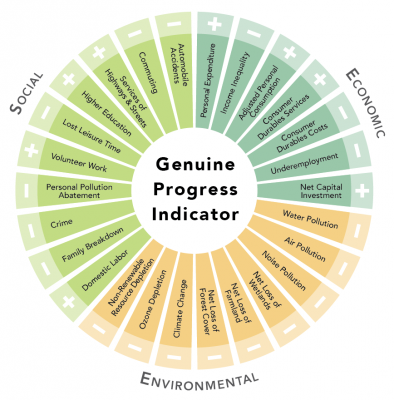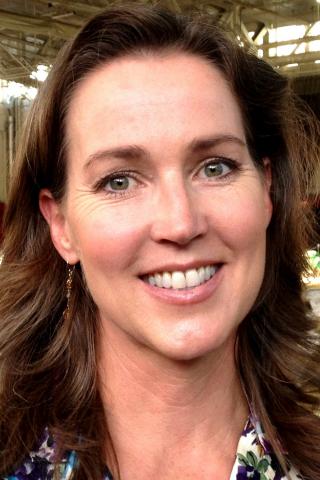
By Cylvia Hayes
There is growing recognition that we need to evolve a healthier, more just economic system. One step toward this is creating better tools to evaluate how the economy is actually performing. Currently, economists and politicians use the Gross Domestic Product (GDP) to assess the health of the economy. If the GDP is going up, the economy is seen to be doing well. If it is going down, the economy is seen to be doing poorly. But the problem is that the only thing GDP measures is how many dollars are flowing through the system; not whether those dollars are making us healthier, happier or more secure.
According to the GDP, the money spent to keep a child in the foster care system or jail registers as just as positive as the same amount of money spent to give a child an education.
The funeral costs for the victims of mass shootings boost the GDP. So does the flurry of gun purchases as people react to growing fear and insecurity. The GDP registers both of those things as an economic gain. Nowhere does it account for the human capital – the potential and talent and social connections – that was lost.
The GDP also fails to account for damage caused to the environment. One of the most glaring examples appeared in an article in the Wall Street Journal on June 15, 2010. It suggested that the BP Deepwater Horizon oil spill might actually benefit the economy. The article noted the loss of thousands of jobs in the fishing and tourism sectors but predicted that this would be offset by the high costs of the clean up and that the likely net impact on the GDP, and by inference the U.S. economy, would be positive.
The GDP fails to account for the erosion of human well-being, natural resource supplies and environmental health. It also perpetuates a limitless growth economic model, suggesting that so long as the economy is growing in size it is growing in the right direction. Yet even the inventor of the GDP, Simon Kuznets, warned, “Distinctions must be kept in mind between quantity and quality of growth, between costs and returns, and between the short and long run. Goals for growth should specific more growth of what and for a what.”
To put it more bluntly, rascally western novelist Edward Abbey pointed out that, “Growth for the sake of growth is the ideology of the cancer cell.” Rather than risk killing our host, the goal should be to create a strong, muscular economy that improves the health of people and the planet.
Fortunately there is a growing global movement working on developing more effective tools for measuring the comprehensive outcomes of our economy. One of the best known is the Genuine Progress Indicator (GPI). The goal of the Genuine Progress Indicator is to measure the true societal wellbeing and health generated or harmed by economic activity. The GPI starts with the same personal consumption data that the GDP is based on, but then makes some crucial distinctions. It adjusts for factors such as income distribution, adds factors such as the value of household and volunteer work, and subtracts factors such as the costs of crime and pollution.
Because GDP and GPI are both measured in monetary terms they can be compared on the same scale. The organizations Redefining Progress and the Center for Sustainable Economy have regularly calculated the U.S. GPI. These calculations show that even when GDP has been growing the health of our national human capital and natural capital has been eroding. Plans are underway for an updated U.S. GPI calculation in 2016.
A number of U.S. states are moving forward with developing GPIs. The front-runner is the state of Maryland. The introduction on the Maryland GPI website reads, “Maryland developed its Genuine Progress Indicator to measure how development activities impact long-term prosperity, both positively and negatively. Here in Maryland and across the globe, people are continually challenged by the need to find a balance between advancing economic gain and ensuring social well-being.”
John Talberth, founder of the Center for Sustainable Economy, is one of the world’s leading GPI practitioners. In addition to working with individual cities and states developing GPI metrics and analysis, Talberth also organized an international online discussion group of practitioners to propose and debate advances to the basic GPI architecture, methods, and data sources under the rubric of “GPI 2.0.” This upgraded 2.0 version of the GPI is reflected in the newly released 2014 Baltimore GPI report.
Transitioning to a new economy will require a multitude of steps and pieces from cooperative ownership models, to reformed corporate structures, to new clean energy and environmental restoration products. One important piece is a more effective and accurate metric. As is oft-stated in business circles, we manage what we measure. The GPI is a useful tool for measuring not only the overall size of the economy, but also how that economy is affecting our wellbeing and the health of our environment.
Additional Information:
http://rprogress.org/sustainability_indicators/genuine_progress_indicator.htm
http://www.demos.org/publication/beyond-gdp-new-measures-new-economy
http://www.3estrategies.org/issues/economic-progress/
 Cylvia Hayes is the CEO of 3EStrategies.
Cylvia Hayes is the CEO of 3EStrategies.
Follow us: Twitter YouTube Facebook